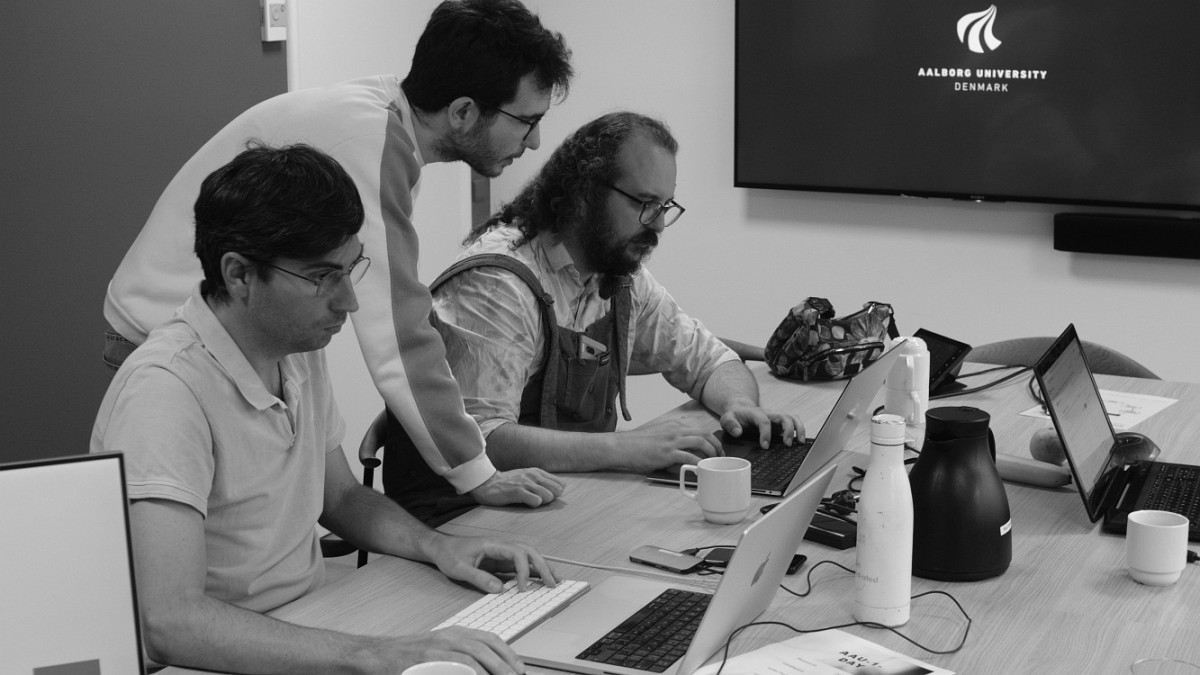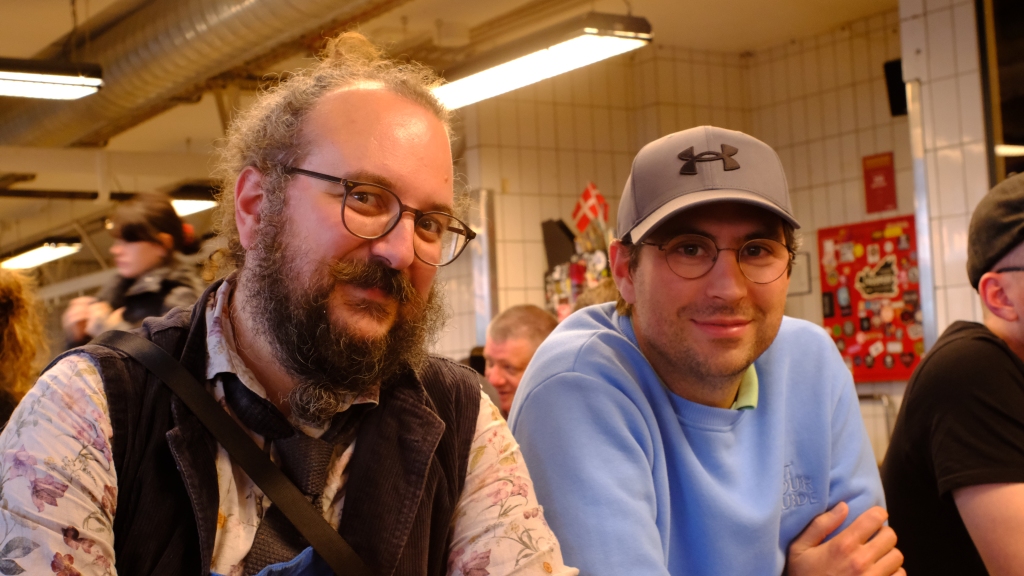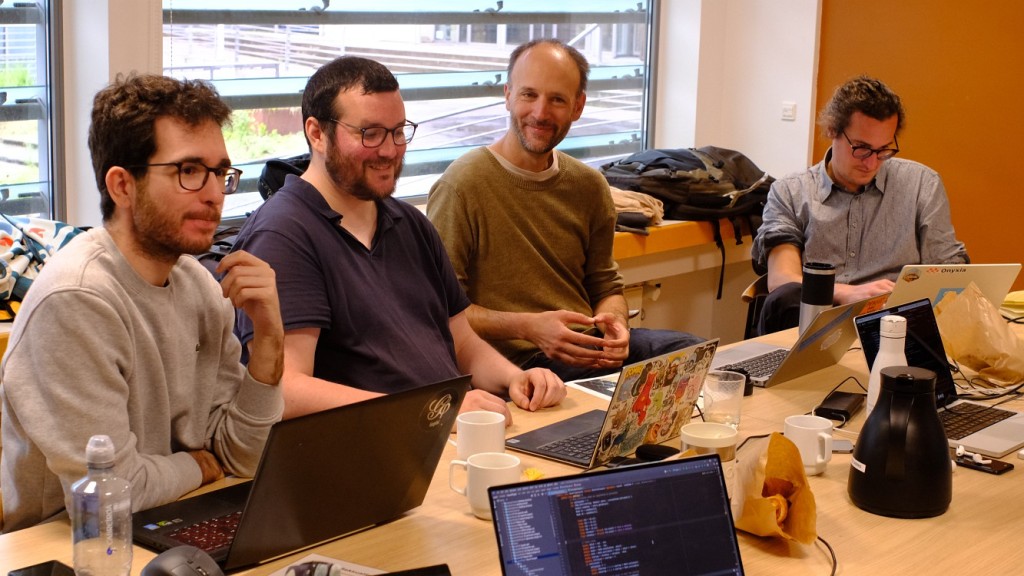This new edition of the Gephi week takes place in Copenhagen, organized by Mathieu Jacomy who lives there and works as a professor at Aalborg University. It was a closed meeting, contrary to the Gephi week 2 years ago in Paris, because of the complexity to organize a public event. This one was smaller and streamlined: 11 participants in one meeting room booked for 5 days. So, what’s happening? I’ll give some personal impressions, interspersed with pictures I took of the event.
The event is pretty important because while Gephi is a passion for all of us, and needs lots of work to develop, the reality is that the actors most involved in the development of Gephi are all super busy with the rest of their lives. The week offers a place and a short window in time where these individuals can work and interact in a highly focused state – that’s 100% Gephi for a couple of days.
One highlight is the participation of Mathieu Bastian (Gephi architect) and Eduardo Ramos (Gephi lead dev), who could spend a few days together and work on the upgrading of Gephi’s viz engine. This is a long term project, started years ago and that perfectly illustrates the difficulty to move on complex subjects with constrained resources.
The promise is to get a new version of the viz engine that will easily accomodate graphs of the size of hundreds of thousands of nodes. Spoiler alert: their project is sufficiently advanced that they could show a demo running within Gephi, and yes gigantic networks can be opened and manipulated just like you’d handle a tiny one today. Looks quite magical. Don’t expect it to be released soon though, as lot of work remains so that the engine works for all platforms and edge cases – that’s many tiny paper cuts to fix.
Another big component of the week is the team of Ouestware working on Gephi lite, which is the web version of Gephi. Lighter than Gephi as the name implies, in the sense that it is not meant to include every feature of Gephi, but evokes a similar experience in terms of graph viz and exploration. It has a much easier learning curve, and it opens Gephi to the features that web technologies afford (modern UI, interfacing with other web services, etc.)
The Ouestware team was joined by Mathieu’s colleagues: Anders Kristian Munk, Johan Irving Søltoft and Lasse Uhrskov Kristensen who provided extensive user reports and insights on Gephi lite (the app being so young, there is still a long road to improve the user experience).
By the way, the development of Gephi lite opens interesting issues: are we witnessing the birth of a kind of “Gephi family” of tools and products? If so, how can it be reflected? Should “Gephi” be called “Gephi desktop” to distinguish it from Gephi lite? What about the visual identity of Gephi? Discussions were exploratory, and in practice the first concrete steps have been taken to redesign the Gephi website to explain better the different assets and use cases for Gephi.
On Mathieu Jacomy’s side, there was interesting work (actually still ongoing, the week is not finished!) on implementing the “connected closeness” algorithm, that he designed and published about (link to the paper, link to the very detailed Observable notebook). What does it do?
It is very simple and powerful: when you layout a network, this algorithm provides a measure of how “good” the layout is. What is “good” then, that’s the big question! A good algorithm is one that brings connected nodes closer to another. Hence the name of the algorithm. Can’t wait to try it!
Another ongoing contribution is by Emilien Schultz, research engineer at ENSAE, who acted both as a participant and an observer: he is interested in Gephi as a topic in sociology of science so he gathered information on the project, all while coding a project that would trace the network of contributors on Github who interacted with Gephi in some capacity. A network that would then be easily explored… in Gephi 🙂
On my side, I spent the week trying to increase the speed of the Force Atlas 2 algorithm, which is this high quality layout developed by Mathieu Jacomy and al., which makes the networks so intelligible. When the graphs are super big (thousands of nodes and dozens of thousands of edges), there are so many computations to be done to lay it out that it is very slow. After 3 days of work, I could double the speed, which is both great but also sligthly disappointing, as I had higher hopes. Besides this result, I learned a lot about the algorithm itself, which has many different parts. It will keep me thinking.
To finish: the atmosphere!
The atmosphere is one of intense focus: participants who made room for a few days to spend time on Gephi and so not wasting a minute. As the pictures show, the meeting room was often silent, just with the noise of keyboard typing. Many or most participants being French, some interruptions came to comment on the political turmoil in France. No tourism on my side except for great culinary experiences in the evening. Copenhagen has great food!
Next steps?
Check out the Gephi website as I’d expect its new version to be published in the not distant future. Then, push me to publish the “speed” version of Force Atlas 2, which is not included in the main Gephi code base yet. And try out Gephi lite, while waiting for the major update to Gephi’s visualization engine! ✨









 Update Gephi (Help > Check for Updates) to get this new layout.
Update Gephi (Help > Check for Updates) to get this new layout.